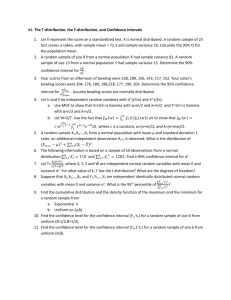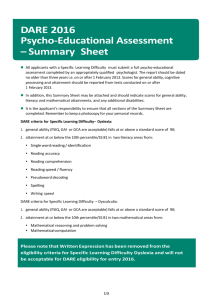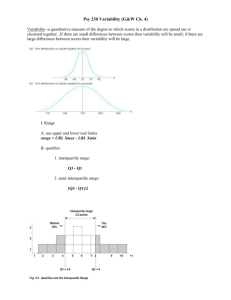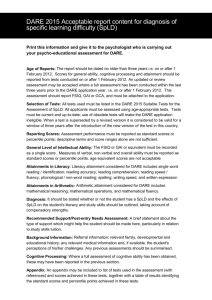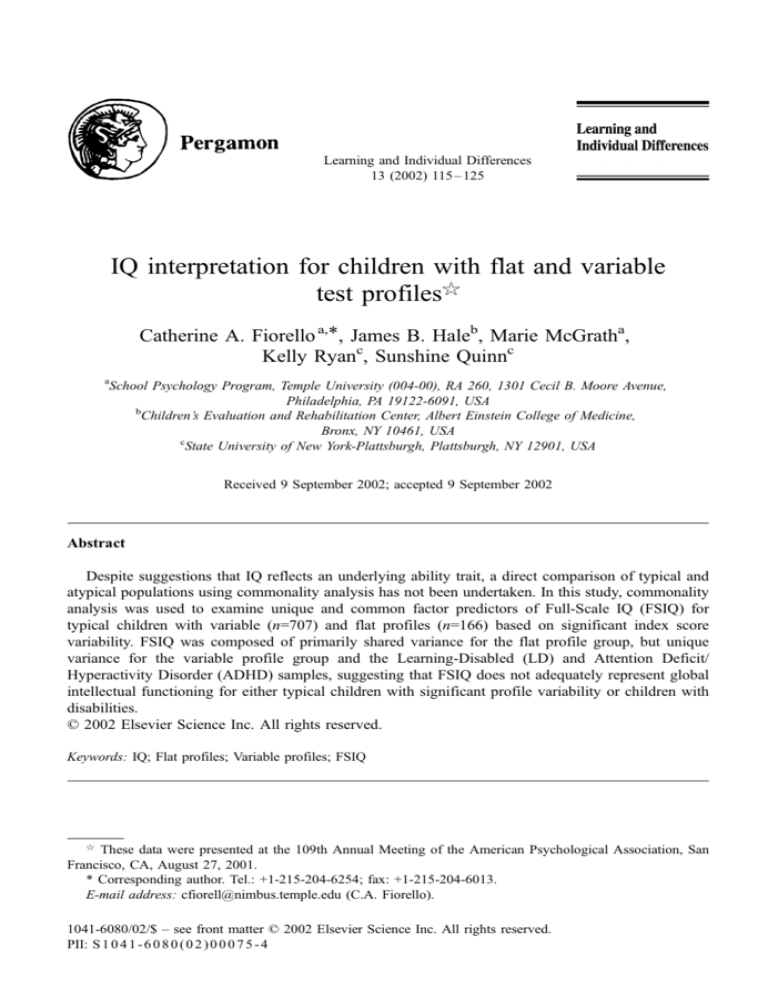
Learning and Individual Differences
13 (2002) 115 – 125
IQ interpretation for children with flat and variable
test profiles$
Catherine A. Fiorello a,*, James B. Haleb, Marie McGratha,
Kelly Ryanc, Sunshine Quinnc
a
School Psychology Program, Temple University (004-00), RA 260, 1301 Cecil B. Moore Avenue,
Philadelphia, PA 19122-6091, USA
b
Children’s Evaluation and Rehabilitation Center, Albert Einstein College of Medicine,
Bronx, NY 10461, USA
c
State University of New York-Plattsburgh, Plattsburgh, NY 12901, USA
Received 9 September 2002; accepted 9 September 2002
Abstract
Despite suggestions that IQ reflects an underlying ability trait, a direct comparison of typical and
atypical populations using commonality analysis has not been undertaken. In this study, commonality
analysis was used to examine unique and common factor predictors of Full-Scale IQ (FSIQ) for
typical children with variable (n=707) and flat profiles (n=166) based on significant index score
variability. FSIQ was composed of primarily shared variance for the flat profile group, but unique
variance for the variable profile group and the Learning-Disabled (LD) and Attention Deficit/
Hyperactivity Disorder (ADHD) samples, suggesting that FSIQ does not adequately represent global
intellectual functioning for either typical children with significant profile variability or children with
disabilities.
D 2002 Elsevier Science Inc. All rights reserved.
Keywords: IQ; Flat profiles; Variable profiles; FSIQ
$
These data were presented at the 109th Annual Meeting of the American Psychological Association, San
Francisco, CA, August 27, 2001.
* Corresponding author. Tel.: +1-215-204-6254; fax: +1-215-204-6013.
E-mail address: cfiorell@nimbus.temple.edu (C.A. Fiorello).
1041-6080/02/$ – see front matter D 2002 Elsevier Science Inc. All rights reserved.
PII: S 1 0 4 1 - 6 0 8 0 ( 0 2 ) 0 0 0 7 5 - 4
116
C.A. Fiorello et al. / Learning and Individual Differences 13 (2002) 115–125
1. Introduction
Since the earliest days of mental testing, views of the structure of intelligence have
differed. A general intelligence ( g) model posits that mental ability can be measured as a
unitary construct. This view has long been espoused by those who consider IQ a meaningful
measure of overall cognitive ability. Among modern researchers, Gottfredson (1997)
contends that g is the best predictor of success, not only in school, but also in later job
training and overall occupational success. It has also been linked to a variety of real-world
outcomes, including educational attainment, income level, and incarceration (Herrnstein &
Murray, 1994). Perhaps the best known of the g proponents is Arthur Jensen (1998a, 1998b),
whose body of work has explored the links between psychometric g and a variety of other
measures. While g proponents do not deny the existence of other factors, they miminize their
importance in explaining cognitive functioning. In contrast, proponents of a multifactor
model of intelligence assume that a variety of cognitive abilities exists and that useful
intelligence tests must measure a variety of abilities rather than a unitary IQ (e.g., Guilford,
1967; Horn & Cattell, 1967; Thurstone, 1938). These theorists focus on the variety of
cognitive abilities manifested through psychometric testing. Guilford’s (1967) Structure of
Intellect Model attempted to recognize the diversity of cognitive abilities by breaking
cognitive processes down into 120 factors, differing in content, operation, and product.
Theorists currently focusing on cognitive processing are elaborating on a model first
articulated in Thurstone’s (1938) Primary Mental Abilities and refined through the work of
Horn and Cattell (1967). While multiple-factor proponents may or may not acknowledge g as
a measure of global cognitive ability, they emphasize the importance of a variety of abilities
in explaining cognitive functioning.
More recently, McGrew and Flanagan (1998) and their colleagues have combined Carroll’s
(1993) hierarchical concept of intelligence with Horn and Cattell’s (1967) multifactorial
model to yield what is known as Cattell–Horn–Carroll or CHC theory. While this type of
hierarchical model, with g at the apex and several broad abilities underneath, is endorsed by
many theorists (e.g., Carroll, 1993; Elliott, 1990; McGrew & Flanagan, 1998), it is not
universally accepted (Neisser et al., 1996). Perhaps one of the most contentious debates in
psychology, the battle between proponents of g and proponents of multiple cognitive abilities
is played out among practitioners as well as theorists.
Clinicians who assess cognitive ability, such as neuropsychologists and school and clinical
psychologists, routinely go beyond the Full-Scale IQ (FSIQ) to look for strengths and
weaknesses among a client’s cognitive skills. For example, in a recent national survey, 89%
of school psychologists indicated that they used index scores, subtest profile analysis, or both
in interpreting their clients’ performance on the Wechsler Intelligence Scale for Children—
Third Edition (WISC-III; Pfeiffer, Reddy, Kletzel, Schmelzer, & Boyer, 2000). Texts for
clinical practitioners present methodologies for interpreting variation in test and subtest
scores as measures of different underlying cognitive abilities (e.g., Kamphaus, 2001; Kaufman, 1994; McGrew & Flanagan, 1998; Sattler, 2001).
Sattler (2001) cautions that the FSIQ may misrepresent a child’s cognitive functioning
level if the Verbal IQ (VIQ) and Performance IQ (PIQ) are significantly different; however, he
C.A. Fiorello et al. / Learning and Individual Differences 13 (2002) 115–125
117
indicates that no empirical evidence exists to indicate when the FSIQ should not be reported
or used in eligibility decisions. Prifitera, Weiss, and Saklofske (1998) recommend that FSIQ
should not be interpreted when differences between VIQ/PIQ or Verbal Comprehension Index
(VCI) and Perceptual Organization Index (POI) scores are extreme, which they define as
differences found in less than about 10% of the population.
Neuropsychologists have traditionally de-emphasized interpretation of FSIQ in favor of
interpreting specific abilities (e.g., Spreen & Strauss, 1998). Recently, Riccio and Hynd
(2000) used MRI to validate the neurological basis for differences in VIQ and PIQ on the
WISC-III, finding that children with a smaller left planum temporale (a part of the brain
associated with language comprehension) showed a significant difference in favor of PIQ. In
addition, Riccio and Hynd’s analysis of the psychometrically purer VCI and POI scores
yielded even stronger differences, with POI exceeding VCI by more than 15 points in
children with smaller left planum temporales.
Several researchers have challenged the validity and utility of profile interpretation
(Glutting, McDermott, Konold, Snelbaker, & Watkins, 1998; Glutting, Youngstrom, Ward,
Ward, & Hale, 1997; McDermott, Fantuzzo, & Glutting, 1990; Watkins, 2000). McDermott et
al. (1990) suggest that clinicians ‘‘just say no’’ to profile analysis and that FSIQs be the only
scores interpreted from an intellectual assessment. Sounding a more restrained warning,
Kamphaus (1998) notes that clinicians often make interpretations based on clinical experience
and judgment that contradict available empirical data and he calls for more research to
support empirically informed interpretations.
Some researchers have argued that FSIQ is a more useful measure than are index scores in
the prediction of academic achievement, and WISC-III hierarchical regression analyses have
indicated that index scores contribute little beyond FSIQ in the prediction of achievement
(Glutting et al., 1997). Concluding that index scores have limited incremental validity,
Glutting et al. (1997) argue that clinicians should interpret FSIQ only, as such interpretation is
the simplest and most efficient method of WISC-III analysis.
However, we find the hierarchical regression method of statistical analysis utilized in these
studies problematic. The methodology employed by Glutting et al. (1997) required that FSIQ
be force-entered first into the regression equations, leaving little variance for the index
predictors. As we and our colleagues have argued elsewhere (Hale, Fiorello, Kavanagh,
Hoeppner, & Gaither, 2001), the WISC-III FSIQ and index scores are largely composed of
the same subtest scores and thus the same variance. Thus, such analyses yield misleading
results. Using the same hierarchical regression procedures, but with index (rather than FSIQ)
scores entered first, Hale et al. (2001) found that FSIQ contributes little to the prediction of
achievement beyond that explained by index scores.
As these analyses demonstrated that hierarchical regression procedures could be misleading, Hale et al. (2001) used regression commonality analysis (see Pedhazur, 1997) to examine
the unique and common predictor variance estimates of FSIQ. This analysis allows one to
determine what proportion of variance in an outcome score is predicted by the unique
contributions of individual variables uncontaminated by multicollinearity, in addition to the
contributions of various combinations of the collinear variables. Using a sample of children
with Learning Disorders (LD), Hale et al. demonstrated that FSIQ variance was largely made
118
C.A. Fiorello et al. / Learning and Individual Differences 13 (2002) 115–125
up of unique, not common or shared, factor variance, thus calling into question the utility of
FSIQ as a unitary measure of ‘‘ability’’ or global intellectual functioning for children with LD.
As intelligence subtest scores are more variable for children with LD, attention deficits, or
neurological impairment than for the population at large (Hynd, Cohen, Riccio, & Arceneaux,
1998), practitioners must evaluate whether FSIQ represents global intellectual functioning for
children with variable profiles. In addition, most children display a significant amount of
variability in their intelligence test profiles (Schinka, Vanderploeg, & Curtiss, 1997), so the
question of whether practitioners should interpret FSIQ as a measure of global intellectual
functioning for typical children with variable profiles becomes an important one.
This study was undertaken to examine the unique and common factor predictors of
FSIQ for the typical population. The purpose was to develop an empirically based
recommendation for the clinical interpretation of WISC-III scores. It was hypothesized
that children in the standardization group who displayed significant index score variability
would show a different pattern of common and shared factor variance estimates of FSIQ
than children without such variability. Additionally, it was hypothesized that FSIQ would
be composed of primarily unique, not shared, factor variance for children with significantly
variable index scores, while FSIQs of children with flat profiles would be composed of
primarily shared variance. In addition, as a comparison, we examined the unique and
common factor predictors of FSIQ for two special clinical groups reported in the manual,
the Learning-Disabled (LD) and Attention Deficit/Hyperactivity Disorder (ADHD) groups.
It was hypothesized that FSIQ would be composed of primarily unique variance for these
groups.
2. Method
The WISC-III–WIAT linking standardization sample data (Psychological Corporation,
1992; Wechsler, 1991), consisting of children who completed both the WISC-III and WIAT,
were used in this study. Participants who obtained an FSIQ below 80 or above 120 were
excluded to ensure that the sample did not include children diagnosed with mental retardation
or giftedness. The final sample (N = 873) consisted of 430 female and 443 male children, with
an average age of 11.5 years (range 6–17 years). The sample was reasonably well matched to
the demographic characteristics of the 1988 census for race/ethnicity, geographic region, and
parent education level, and was comparable in terms of grade level distribution (see
Psychological Corporation, 1992).
In addition, two WISC-III special group samples were used for comparison purposes
(Wechsler, 1991). The children with LD (n = 47) consisted of 39 males and 8 females,
primarily of European American race/ethnicity (n = 43). The children with ADHD (n = 51)
consisted of 48 males and 3 females, also primarily of European American race/ethnicity
(n = 50). Further information about these samples can be found in the WISC-III and WIAT
test manuals (Psychological Corporation, 1992; Wechsler, 1991).
The standardization sample was divided into two groups, the variable profile (n = 707)
group and the flat profile (n = 166) group, based on the degree of index score variability.
C.A. Fiorello et al. / Learning and Individual Differences 13 (2002) 115–125
119
Children included in the variable profile group had one or more WISC-III index score (VCI,
POI, Freedom from Distractibility Index [FDI], and Processing Speed Index [PSI]) differences that was statistically significant (a=.05) as specified in the WISC-III manual (Wechsler,
1991, p. 261).
Using standard commonality analysis procedures (Pedhazur, 1997), unique and shared
index score variance estimates of FSIQ were calculated separately for each group. Unique and
shared index score variance estimates for the flat profile and variable profile groups were then
compared. In addition, a comparison was made between the variable profile group and the LD
and ADHD samples.
3. Results
Standard commonality analysis notation is used in the results. Unique factors are
designated by U, with a subscript indicating the WISC-III index score that makes up the
factor. Common factors are designated by C, with the subscripts indicating the WISC-III
index scores that contribute to the factor. Index score abbreviations are as follows: VCI, POI,
FDI, and PSI.
3.1. Flat profile and variable profile group comparison
As noted in Table 1, the two groups were comparable in terms of gender distribution, age
distribution, and racial/ethnic makeup. In addition, an ANOVA comparison of the variable
profile (mean = 100.24, S.D. = 10.33) and flat profile (mean = 100.21, S.D. = 10.78) group
FSIQ means revealed no significant difference ( F = 0.001, P=.970).
The commonality results for the flat and variable profile groups are reported in Tables 2
and 3, respectively. For the flat profile group, a large portion of FSIQ variance could be
Table 1
Comparison of the variable profile and flat profile groups
Variable profile
Total (N = 873)
Gender
Male
Female
Race/ethnicity
European American
African American
Latino
Other
Age (months)
Mean
S.D.
Flat profile
n
%
n
%
707
81
166
19
360
347
51
49
83
83
50
50
556
75
65
11
79
11
9
2
128
19
17
2
77
11
10
1
137.99
37.41
139.51
38.63
120
C.A. Fiorello et al. / Learning and Individual Differences 13 (2002) 115–125
Table 2
Commonality analysis for FSIQ, flat profile standardization group
Variance explained
VC
UVC
UPO
UFD
UPS
CVCPO
CVCFD
CVCPS
CPOPS
CVCPOFD
CVCPOPS
CVCFDPS
CPOFDPS
CVCPOFDPS ( g)
Unique
Common
Total
PO
FD
PS
.04526
.03654
.00373
.00249
.04204
.02394
.01007
.06851
.05345
.02467
.63609
.04526
.85877
.90403
.04204
.02394
.01239
.06851
.05345
.01245
.63609
.03654
.83293
.86947
.01007
.01239
.06851
.02467
.01245
.63609
.00373
.77562
.77935
.05345
.02467
.01245
.63609
.00249
.75108
.75357
Commonalities < .01 not displayed.
accounted for by shared (89%) rather than unique (9%) factor predictors, suggesting that
FSIQ is interpretable as a global measure of intellectual functioning for these children. A
comparison of unique and common variance estimates for the flat profile group revealed that
the most important commonality in predicting FSIQ was CVCPOFDPS (accounting for 64% of
Table 3
Commonality analysis for FSIQ, variable profile standardization group
Variance explained
VC
UVC
UPO
UFD
UPS
CVCPO
CVCFD
CPOPS
CFDPS
CVCPOFD
CVCFDPS
CVCPOFDPS ( g)
Unique
Common
Total
PO
FD
PS
.30637
.26518
.01026
.02905
.14350
.09823
.14350
.09823
.02301
.05245
.01690
.01821
.30637
.32345
.62982
Commonalities < .01 not displayed.
.05245
.01821
.26518
.24740
.51258
.02301
.05245
.01690
.01821
.01026
.20356
.21382
.01690
.01821
.02905
.06668
.09573
C.A. Fiorello et al. / Learning and Individual Differences 13 (2002) 115–125
121
the variance), with most of the additional variance accounted for by other common factors
involving VCI and POI.
In contrast, for the variable profile group, a large portion of FSIQ variance could be
accounted for by unique (61%) rather than shared (36%) Index score predictors, suggesting
that FSIQ may not adequately represent true ‘‘ability’’ or ‘‘potential’’ for this group. A
comparison of unique and common variance estimates for the variable profile group revealed
a very different pattern for predictors. Two unique factors, UVC (31%) and UPO (27%),
accounted for the majority of FSIQ variance, while several commonalities also accounted
for notable amounts of variance, including CVCPO (14%), CVCFD (10%), and CVCPOFD (5%).
CVCPOFDPS, the commonality consisting of all four index scores, accounted for only 2% of
the variance. Overall, the variable profile group presented with a more factorially complex
FSIQ, indicating that interpretation of FSIQ as a global measure can be particularly
misleading with this group, which constituted a substantial majority of the standardization
sample.
3.2. Variable profile and clinical groups comparison
A comparison of unique and common variance estimates for the LD group revealed that
58% of the variance in FSIQ was due to unique contributions of the index scores (see Table
4). Two unique factors, UVC (31%) and UPO (23%), accounted for the majority of FSIQ
variance. Several commonalities also accounted for notable amounts of variance, including
CVCFD (10%), CVCPOFD (9%), CPOPS (7%), CPOFDPS (6%), and CPOFD (5%). However,
CVCPOFDPS, the common factor consisting of all four index scores, accounted for only 3%
Table 4
Commonality analysis for FSIQ, LD special validity study group
Proportion of variance explained
VC
UVC
UPO
UFD
UPS
CVCPO
CVCFD
CPOFD
CPOPS
CFDPS
CVCPOFD
CPOFDPS
CVCPOFDPS ( g)
Unique
Common
Total
PO
FD
PS
.30746
.22513
.01539
.03448
.02264
.09859
.02264
.04929
.07118
.08972
.02726
.30746
.20700
.51446
Commonalities < .01 not displayed.
.08972
.05754
.02726
.22513
.30022
.52535
.09859
.04929
.01210
.08972
.05754
.02726
.01539
.34102
.35641
.07118
.01210
.05754
.02726
.03448
.13687
.17135
122
C.A. Fiorello et al. / Learning and Individual Differences 13 (2002) 115–125
Table 5
Commonality analysis for FSIQ, ADHD special validity study group
Proportion of variance explained
VC
UVC
UPO
UFD
UPS
CVCPO
CVCFD
CPOFD
CPOPS
CVCPOFD
CVCPOPS
CPOFDPS
CVCPOFDPS ( g)
Unique
Common
Total
PO
FD
PS
.23843
.18007
.01852
.03684
.18811
.05467
.13315
.01460
.01971
.23843
.40177
.64020
.18811
.03580
.04547
.13315
.01460
.01100
.01971
.18007
.44784
.62791
.05467
.03580
.04547
.13315
.01100
.01971
.01852
.25701
.27553
.01460
.01100
.01971
.03684
.08455
.12139
Commonalities < .01 not displayed.
of the FSIQ variance. The factorial complexity of the LD group’s FSIQ data suggests that
interpretation of FSIQ as a global measure may be inadvisable for this group.
A comparison of unique and common variance estimates for the ADHD group revealed
that 47% of the variance in FSIQ was due to unique contributions of the Index scores (see
Table 5). The unique contributions of UVC (24%) and UPO (18%), together with the
Fig. 1. Comparison of sources of variance in FSIQ.
C.A. Fiorello et al. / Learning and Individual Differences 13 (2002) 115–125
123
commonality CVCPO (19%), accounted for the majority of FSIQ variance. The UPS accounted
for 4% of FSIQ variance and CVCPOFD (13%) and CVCFD (5%) also accounted for notable
amounts of variance. CVCPOFDPS, the common factor consisting of all four index scores,
accounted for only 2% of the FSIQ variance. Since the ADHD group, like the LD group,
presented with a factorially complex FSIQ, interpretation of FSIQ as a global measure could
be problematic for this group.
Although there are differences for the two clinical groups and the variable profile group,
the overall pattern of findings is similar (see Fig. 1). For all three groups, the CVCPOFDPS
factor containing all four index scores explains little of the FSIQ variance, with percentages
ranging from 2% to 3%. In addition, all three groups show a large proportion of unique index
score contributions to FSIQ, ranging from 47% to 61% of the variance. In contrast, the flat
profile group shows the reverse pattern, with CVCPOFDPS explaining 64% of the variance in
FSIQ and unique factors contributing only 9%.
4. Discussion
Clinicians have often argued that FSIQ may misrepresent an individual’s level of cognitive
functioning when differences between component scores are extreme (Kamphaus, 2001;
Kaufman, 1994; Prifitera et al., 1998). However, many researchers have challenged profile
interpretation and called for interpretation only at the FSIQ level (Glutting et al., 1997, 1988;
McDermott et al., 1990; Watkins, 2000). The results of this study support clinicians who
examine an individual’s pattern of index scores to ensure that FSIQ accurately reflects the
examinee’s level of general intellectual functioning. For the children with flat profiles in this
study, the FSIQ appears to be a global measure of intellectual functioning. However, for
children with variable profiles (over 80% of the standardization sample), FSIQ is composed
of more unique than shared factor variance. This suggests that for about four-fifths of the
typical population, FSIQ may not adequately represent global intellectual functioning. The
findings described above suggest that practitioners would do well to de-emphasize FSIQ as a
measure of ability and place greater emphasis on index scores, especially when significant
index score differences are evident.
In addition to index score interpretation, exploration of common skills across factors may
have utility. Using the Wechsler-defined index scores in this study revealed complex
interactions that may be elucidated in future analyses. CHC theory provides a model that
may more clearly differentiate the cognitive skills underlying WISC-III performance
(Flanagan, McGrew, & Ortiz, 2000). Hale et al. (2001) found that converting subtest scores
into CHC-based ability scores produced fewer negative commonalities than the index scores
in predicting academic achievement and therefore yielded more clearly interpretable results.
In addition, Flanagan (2000) found that supplementing Wechsler scores using a CHC-based
cross-battery approach increased the amount of variance in reading achievement that could be
explained. McGrew, Flanagan, Keith, and Vanderwood (1997) and McGrew and Knopik
(1993) have identified the contributions of specific cognitive abilities beyond g in reading,
writing, and mathematics achievement. In addition, Woodcock (1993) recommends an
124
C.A. Fiorello et al. / Learning and Individual Differences 13 (2002) 115–125
analysis of the information processing demands of intelligence test tasks in order to improve
interpretation.
While these results present compelling evidence against uniform interpretation of global
FSIQ, they also suggest that we must rethink our conception of intelligence test results in
relation to intelligence. If FSIQ is not interpretable as a unitary measure for four-fifths of
typical children, in what sense can it be called a measure of general intelligence at all? If
FSIQ can only be meaningfully interpreted in those children who do not display significant
cognitive variability, then it is simply an ability summary and not necessarily an accurate
reflection of an underlying construct of intelligence. By reporting FSIQ regardless of subtest
or factor variability, we may be contributing to the reification of a concept that has outlived its
usefulness.
References
Carroll, J. B. (1993). Human cognitive abilities: a survey of factor-analytic studies. New York: Press Syndicate of
the University of Cambridge.
Elliott, C. D. (1990). Differential ability scales: introductory and technical handbook. San Antonio, TX: Psychological Corporation.
Flanagan, D. P. (2000). Wechsler-based CHC cross-battery assessment and reading achievement: strengthening the
validity of interpretations drawn from Wechsler scores. School Psychology Quarterly, 15(3), 295 – 329.
Flanagan, D. P., McGrew, K. S., & Ortiz, S. O. (2000). The Wechsler intelligence scales and Gf – Gc theory: a
contemporary approach to interpretation. Needham Heights, MA: Allyn and Bacon.
Glutting, J. J., McDermott, P. A., Konold, T. R., Snelbaker, A. J., & Watkins, M. W. (1998). More ups and downs
of subtest analysis: criterion validity of the DAS with an unselected cohort. School Psychology Review, 27,
599 – 612.
Glutting, J. J., Youngstrom, E. A., Ward, T., Ward, S., & Hale, R. L. (1997). Incremental validity of WISC-III
factor scores in predicting achievement: what do they tell us? Psychological Assessment, 9, 295 – 301.
Gottfredson, L. S. (1997). Why g matters: the complexity of everyday life. Intelligence, 24, 79 – 132.
Guilford, J. P. (1967). The nature of human intelligence. New York: McGraw-Hill.
Hale, J. B., Fiorello, C. A., Kavanagh, J. A., Hoeppner, J. B., & Gaither, R. A. (2001). WISC-III predictors of
academic achievement for children with learning disabilities: are global and factor scores comparable? School
Psychology Quarterly, 16, 31 – 55.
Herrnstein, R. J., & Murray, C. (1994). The bell curve: intelligence and class structure in American life. New
York: Free Press.
Horn, J. L., & Cattell, R. B. (1967). Age differences in fluid and crystallized intelligence. Acta Psychologica, 26,
107 – 129.
Hynd, G. W., Cohen, M. J., Riccio, C. A., & Arceneaux, J. M. (1998). Neuropsychological basis of intelligence
and the WISC-III. In A. Prifitera, & D. H. Saklofske (Eds.), WISC-III clinical use and interpretation: scientist – practitioner perspectives ( pp. 203 – 226). San Diego, CA: Academic Press.
Jensen, A. R. (1998a). The g factor and the design of education. In R. J. Sternberg, & W. M. Williams (Eds.),
Intelligence, instruction, and assessment: theory into practice ( pp. 111 – 131). Mahwah, NJ: Erlbaum.
Jensen, A. R. (1998b). The g factor: the science of mental ability. Westport, CT: Praeger.
Kamphaus, R. W. (1998). Intelligence test interpretation: acting in the absence of evidence. In A. Prifitera, & D. H.
Saklofske (Eds.), WISC-III clinical use and interpretation: scientist – practitioner perspectives ( pp. 39 – 57).
San Diego, CA: Academic Press.
Kamphaus, R. W. (2001). Clinical assessment of child and adolescent intelligence (2nd ed.). Needham Heights,
MA: Allyn and Bacon.
C.A. Fiorello et al. / Learning and Individual Differences 13 (2002) 115–125
125
Kaufman, A. S. (1994). Intelligent testing with the WISC-III. New York: Wiley.
McDermott, P. A., Fantuzzo, J. W., & Glutting, J. J. (1990). Just say no to subtest analysis: a critique on Wechsler
theory and practice. Journal of Psychoeducational Assessment, 8, 290 – 302.
McGrew, K. S., & Flanagan, D. P. (1998). The intelligence test desk reference (ITDR): a Gf – Gc cross-battery
approach to intelligence test interpretation. Boston, MA: Allyn and Bacon.
McGrew, K. S., Flanagan, D. P., Keith, T. Z., & Vanderwood, M. (1997). Beyond g: the impact of Gf – Gc specific
cognitive abilities research on the future use and interpretation of intelligence tests in the schools. School
Psychology Review, 26(2), 189 – 210.
McGrew, K. S., & Knopik, S. N. (1993). The relationship between the WJ-R Gf – Gc cognitive clusters and writing
achievement across the life-span. School Psychology Review, 22, 687 – 695.
Neisser, U., Boodoo, G., Bouchard Jr., T. J., Boykin, A. W., Brody, N., Ceci, S. J., Halpern, D. F., Loehlin, J. C.,
Perloff, R., Sternberg, R. J., & Urbina, S. (1996). Intelligence: knowns and unknowns. American Psychologist,
51, 77 – 101.
Pedhazur, E. J. (1997). Multiple regression in behavioral research: explanation and prediction (3rd ed.). Orlando,
FL: Holt, Rinehart and Winston.
Pfeiffer, S. I., Reddy, L. A., Kletzel, J. E., Schmelzer, E. R., & Boyer, L. M. (2000). The practitioner’s view of IQ
testing and profile analysis. School Psychology Quarterly, 15, 376 – 385.
Prifitera, A., Weiss, L. G., & Saklofske, D. H. (1998). The WISC-III in context. In A. Prifitera, & D. H.
Saklofske (Eds.), WISC-III clinical use and interpretation: scientist – practitioner perspectives ( pp. 1 – 38).
San Diego, CA: Academic Press.
Psychological Corporation (1992). Wechsler Individual Achievement Test manual. San Antonio, TX: Author.
Riccio, C. A., & Hynd, G. W. (2000). Measurable biological substrates to Verbal-Performance differences in
Wechsler scores. School Psychology Quarterly, 15, 386 – 399.
Sattler, J. M. (2001). Assessment of children: cognitive applications. La Mesa, CA: Jerome M. Sattler.
Schinka, J. A., Vanderploeg, R. D., & Curtiss, G. (1997). WISC-III subtest scatter as a function of highest subtest
scaled score. Psychological Assessment, 9, 83 – 88.
Spreen, O., & Strauss, E. (1998). A compendium of neuropsychological tests: administration, norms, and commentary (2nd ed.). New York: Oxford University Press.
Thurstone, L. L. (1938). Primary mental abilities. Chicago, IL: University of Chicago Press.
Watkins, M. W. (2000). Cognitive profile analysis: a shared professional myth. School Psychology Quarterly, 15,
465 – 479.
Wechsler, D. (1991). Manual for the Wechsler Intelligence Scale for Children—Third Edition. San Antonio, TX:
Psychological Corporation.
Woodcock, R. W. (1993). An information processing view of Gf – Gc theory. Journal of Psychoeducational
Assessment, Monograph Series, Woodcock – Johnson Psycho-Educational Battery—Revised, 80 – 102.



